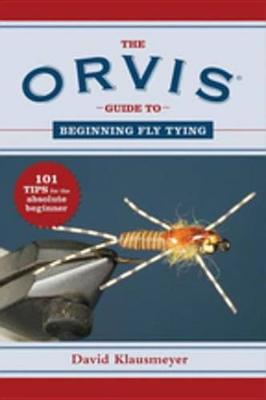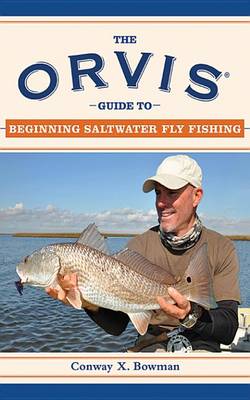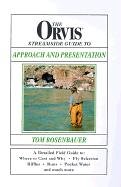Orvis Guides
4 total works
Attention fly fishers! Here is a fly-tying book you must own. Endorsed by Orvis, the best-known name in fly-fishing gear, it will give you all the tools you need to begin tying your own flies.
Here, with step-by-step instructions and full-color photographs you can learn:
Before you know it, you'll be tying such flies as the Wooly Bugger, Clouser minnow, beadhead soft hackle nymphs, Adams dry fly, and Hare's Ear nymph. You'll also get solid advice on how to set up a well-organized fly-tying area, so you can enjoy this fascinating craft in ease and comfort.
Fly Tyer magazine editor David Klausmeyer shares his Five Golden Rules for tying better flies. Many books say they are for beginners but then quickly turn fly tying into a series of complicated finger calisthenics. The Orvis Guide to Beginning Fly Tying really is for the reader who has never made a fly. Catch fish with flies that you've tied on your own, and you'll get more enjoyment from the rich sport of fly fishing.
Here, with step-by-step instructions and full-color photographs you can learn:
- How to read a fly recipe
- Choose the correct tools (including vises, bobbins, threaders, dubbing needles, and hair stackers)
- Select the right materials (everything from dry fly saddles, threads, beads, and Krystal Flash, to hooks, wires, cements, and paints)
- Pick the best flies to tie first
Before you know it, you'll be tying such flies as the Wooly Bugger, Clouser minnow, beadhead soft hackle nymphs, Adams dry fly, and Hare's Ear nymph. You'll also get solid advice on how to set up a well-organized fly-tying area, so you can enjoy this fascinating craft in ease and comfort.
Fly Tyer magazine editor David Klausmeyer shares his Five Golden Rules for tying better flies. Many books say they are for beginners but then quickly turn fly tying into a series of complicated finger calisthenics. The Orvis Guide to Beginning Fly Tying really is for the reader who has never made a fly. Catch fish with flies that you've tied on your own, and you'll get more enjoyment from the rich sport of fly fishing.
- Covers all the basics-from rods, lines, reels, and tippets to the actual practice of identifying and catching fish to using the moon, weather, and tides in your favor
- The key to fun and effective fishing
- An authoritative guide to saltwater fly fishing
Conway Bowman, an expert saltwater fly fisher, wrote this Orvis fly fishing guide. He offers useful techniques and advice for the beginner fisher. This unique fly fishing book for beginners is ideal for the novice who wants to learn and perfect their skills. Written with the prestigious Orvis Company, this saltwater fishing book is meant to guide and teach fishers that want to start their adventure of saltwater fly fishing but don't quite know where to start. Bowman answers questions varying from how to identify saltwater fish to what equipment is needed to proven techniques to catch the best fish.
With hundreds of full-color photographs to emphasize Bowman's wisdom, The Orvis Guide to Beginning Saltwater Fly Fishing is the true companion for the potential fisher who wants to catch the best fish.
Shows the fly fisher where to cast, why, and what kind of fly to use.
The Orvis Guide to Fly Fishing
by Tom Rosenbauer, David Klausmeyer, and Conway X. Bowman
Published 2 September 2014
In this compendium of fly fishing from three of the most respected names in the sport, Tom Rosenbauer, David Klausmeyer, and Conway X. Bowman share all of their most successful fly-fishing secrets. With tips on fresh- and saltwater fly fishing and tying flies, this book will help readers become the best flyfishermen they can be. The chapters discuss a wide range of fly-fishing topics, including:
Choosing the right equipment, such as rods, reels, fly lines, and waders
Casting under different conditions
How to find and catch trout
Which tides are best for saltwater fly fishing
Essential items to pack for a saltwater fly-fishing trip
How to prepare for emergency situations
Taking care of your tackle
Selecting the right materials for tying flies
Tying dry flies that ride higher and float longer
And much more
Never has there been a more comprehensive guide to the fulfilling sport of fly fishing. To catch that trophy you've been waiting for, The Orvis Guide to Fly Fishing is the perfect companion on your next fly-fishing adventure.
Skyhorse Publishing is proud to publish a broad range of books for fishermen. Our books for anglers include titles that focus on fly fishing, bait fishing, fly-casting, spin casting, deep sea fishing, and surf fishing. Our books offer both practical advice on tackle, techniques, knots, and more, as well as lyrical prose on fishing for bass, trout, salmon, crappie, baitfish, catfish, and more. While not every title we publish becomes a New York Times bestseller or a national bestseller, we are committed to publishing books on subjects that are sometimes overlooked by other publishers and to authors whose work might not otherwise find a home.
Choosing the right equipment, such as rods, reels, fly lines, and waders
Casting under different conditions
How to find and catch trout
Which tides are best for saltwater fly fishing
Essential items to pack for a saltwater fly-fishing trip
How to prepare for emergency situations
Taking care of your tackle
Selecting the right materials for tying flies
Tying dry flies that ride higher and float longer
And much more
Never has there been a more comprehensive guide to the fulfilling sport of fly fishing. To catch that trophy you've been waiting for, The Orvis Guide to Fly Fishing is the perfect companion on your next fly-fishing adventure.
Skyhorse Publishing is proud to publish a broad range of books for fishermen. Our books for anglers include titles that focus on fly fishing, bait fishing, fly-casting, spin casting, deep sea fishing, and surf fishing. Our books offer both practical advice on tackle, techniques, knots, and more, as well as lyrical prose on fishing for bass, trout, salmon, crappie, baitfish, catfish, and more. While not every title we publish becomes a New York Times bestseller or a national bestseller, we are committed to publishing books on subjects that are sometimes overlooked by other publishers and to authors whose work might not otherwise find a home.



